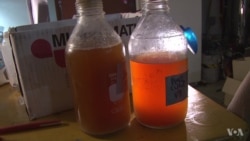Only four ingredients are needed to make one of the oldest staples of mankind. Mix water, hops, malt and yeast and you’re well on your way to making beer. But it's beer's smallest ingredient that's making the biggest splash today.
The earliest recipes for beer typically didn't list its most important ingredient - yeast.
Melissa Hoffmann, quality control head at Lost Rhino Brewing Company in Ashburn, Virginia, says the single-celled fungus is a bit of an unsung hero.
“You know back in the day, they didn't know why beer fermented,” she told VOA. “They thought it was God. It was like ‘oh, God is doing this, making this miraculous thing.’ They’d pop hops, water, and malt [together], and all of a sudden they have a fermented product.”
But Hoffmann and her colleagues recognize the importance, and uniqueness of that missing ingredient.
Most brewer’s yeast are limited to a few types that have been cultivated in labs and breweries for decades. But the Lost Rhino staff also experiments with strains of wild yeast. For example, they are currently reviving their “Bone Dusters” amber ale, which had yeast cultivated from a whale bone fossil.
The quest for wild yeast
Non-domesticated forms of yeast can be found everywhere, even floating in the air.
Alex Lynch, barrel master with Lost Rhino, has experimented with growing wild yeast to create a new beer. “The original beer was just from the air,” said Lynch. “We were using sanitary practices but whatever happened to come into that beer and fermented it. It’s unique to us, it’s unique to our region. It came out pretty well.”
Using a cotton swab and a growth plate, Hoffmann demonstrated how you can source yeast from the most unexpected places.
She explained that the yeast for Lost Rhino’s blended “Geuzilla” beer, “was harvested from the parking lot and put into the barrel and we didn’t take it out for two years. So it kinda sat there, we didn’t know what was going to happen. Just something grew from the parking lot, we popped the yeast in and it spontaneously fermented.”
Worth waiting for
With the right equipment, you can grow your very own yeast strain for brewing. But be warned, not every yeast makes a good beer. And wild yeast takes much longer to ferment.
“These beers take up to three years to mature,” Lynch said. “So that’s just so much time and so much raw ingredients just sitting on a shelf or sitting in a barrel.” Occasionally the wild yeast isn’t the right strain and will produce sludge rather than beer, but it’s thankfully a rare occurrence.
Experimentation can be a slow, meticulous process, but with the right ingredients -- it's a process that can reward you with a tasty brew.
So remember, the key ingredient to beer is all around us. Cheers to yeast!







